Veil Nebula--one side of it
Finally a clear-ish night! I spent almost five hours capturing data, most of it after midnight, when the skies cleared noticeably. And I spent the majority of that time on the Eastern Veil Nebula (Caldwell 33). The big bright area is NGC 6992, and all of this comprises one side (east side) of the Veil Nebula, a supernova remnant from a massive star that ended it all around 8,000 years ago. I will come back on another clear night to get the brighter and larger Western Veil. And this nebula is large, roughly 3 degrees in diameter, covering 36 times the area of a full moon. I shot this in Ha and OIII, 22 x 5 minute exposures for each filter, with the WilliamOptics GT81 and ZWO ASI1600MM-Pro mono camera running at -20C.

Here's the William Optics GT81 and ZWO cameras I'm using for narrowband imaging:
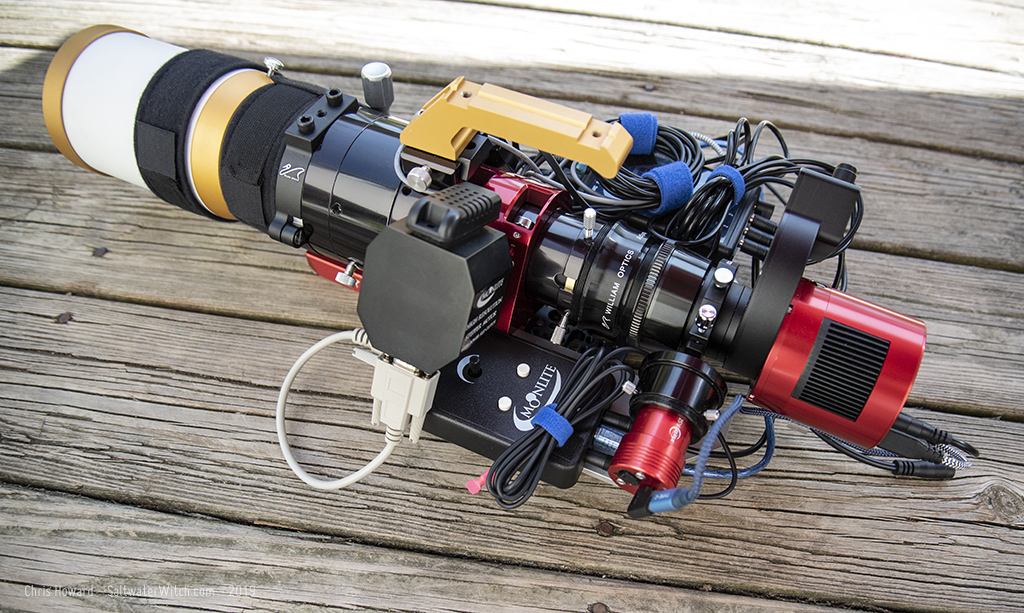
Here's a crop of NGC 6992, 6995, et. al. Eastern Veil Nebula is a supernova remnant in Cygnus, made up of clouds of dust and ionized hydrogen and oxygen.
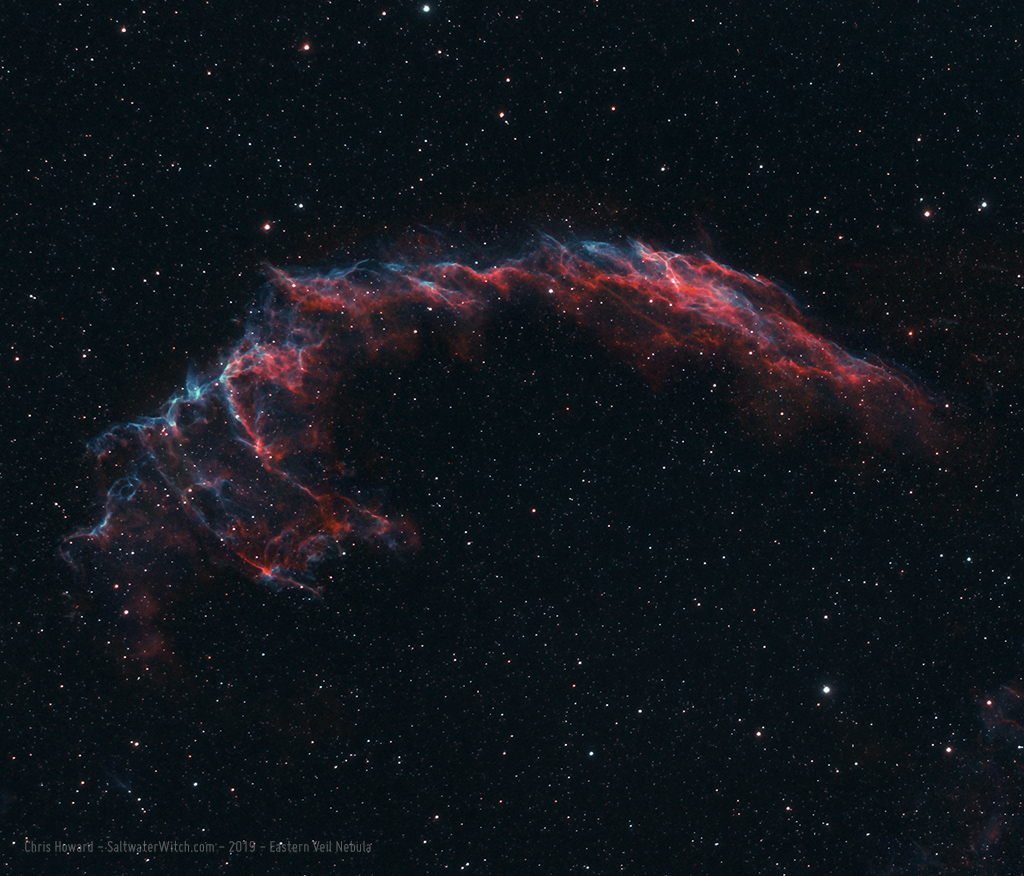
Posted May 25, 2019
Messing around with Messier in Infrared
We finally had several hours of clear night sky--not spectacular, but I'll take what I can get this time of year. That whole “April showers bring May flowers” thing really applies to this region of the planet. I think we’ve had four or five full clear nights in the last couple months--and I can’t remember multiple clear days in a row, but I am looking forward to more opportunities to capture the night skies soon--early summer through the winter.
One of the paths I’m currently on is to be more productive--in very concrete terms. I simply want to produce more imaging data per night than I have before. One way to do this is to upgrade equipment and pile on new devices, which translates into an EQ mount with more capacity and another scope and camera to double the exposure time. In other words, spend more money, which I don’t want to do.
Another option is to improve the efficiency of my current setup and systems. This is where I’m presently spending my time and effort, squeezing out 5-10 minutes per hour I was losing with slower hardware and application workflows (per image download times, auto-focus and plate-solving routines, etc). I will test out NINA (https://nighttime-imaging.eu) at some point, because I’ve heard great things about its speed. I’m currently using Sequence Generator Pro 3 with my narrowband refractor setup (William Optics GT81, Moonlite Focuser, ZWO ASI1600MM-Pro mono, and ASI120MM-Mini Guide-cam), and with a few exceptions and idiosyncrasies, which often turn out to be ASCOM or device-specific weirdness, not an SGP problem, things are going smoothly.
I have been working through a couple different configurations of equipment, automation systems, and application workflows, mostly focused on building a narrowband setup with two cables--USB3 and a single 12vdc 10 amp line. For now, I’m using Windows 10 on a fanless Celeron-based system, which easily handles the processing load during capture and plate-solving. On the scope itself I have the Moonlite Focuser controller, a powered USB 3 hub, and all power, environment, and dew control functions managed through a Pegasus Astro Pocket Powerbox.
I ran my first in-depth test of this system last night, jumping all over the sky east of the meridian, taking several 1-minute subs of M3, M10, M12, M13, M51, and NGC 6826 (blinking planetary nebula in Cygnus). I have to say, my impression of SGP has not changed. I already had a high opinion of it, and coming back to it for version 3 has been fun and exciting--and more importantly, productive. I was skipping all over the sky last night, pulling up the Framing and Mosaic wizard half a dozen times, and appending new targets to the sequence. I would have kept going after midnight, but the clouds rolled in and shut the show down.
Near-IR filter notes--something to consider if you’re guiding off-axis: I’m using Astronomik 1.25” narrowband filters (Ha, OIII, SII) in this ZWO EFW, but I also have an Optolong IR 685nm longpass filter installed in the 5th place. I ran into a slight issue with off-axis guiding because the IR filter’s focal offset with the Astronomik’s is so great that it throws off the focus of guide camera. I have to plan to do any near-IR exposures at the end of any sequence because this forces me to adjust the focus in PHD2 for the ZWO ASI120MM.
Here are a few shots from last night, using the Optolong 685nm longpass filter.
Whirlpool Galaxy (M51) in near-Infrared, WIlliam Optics GT81, ZWO ASI1600MM-Pro mono, 685nm Near-IR longpass filter. M51 is around 23 million lightyears away from us in the constellation Canes Venatici. It’s a tiny view of the galaxies, but I’m impressed with the trailing gas and dust that IR managed to capture.

M10 (NGC 6254) is a globular cluster of stars about 14,000 lightyears away in the constellation of Ophiuchus. 4 x 60 second subs in near-Infrared, William Optics GT81, ZWO ASI1600MM-Pro mono, 685nm Near-IR longpass filter. In IR the stars are really distinct in the cluster, and I want to come back with RGB and use the IR frames for luminance, and see how that looks.
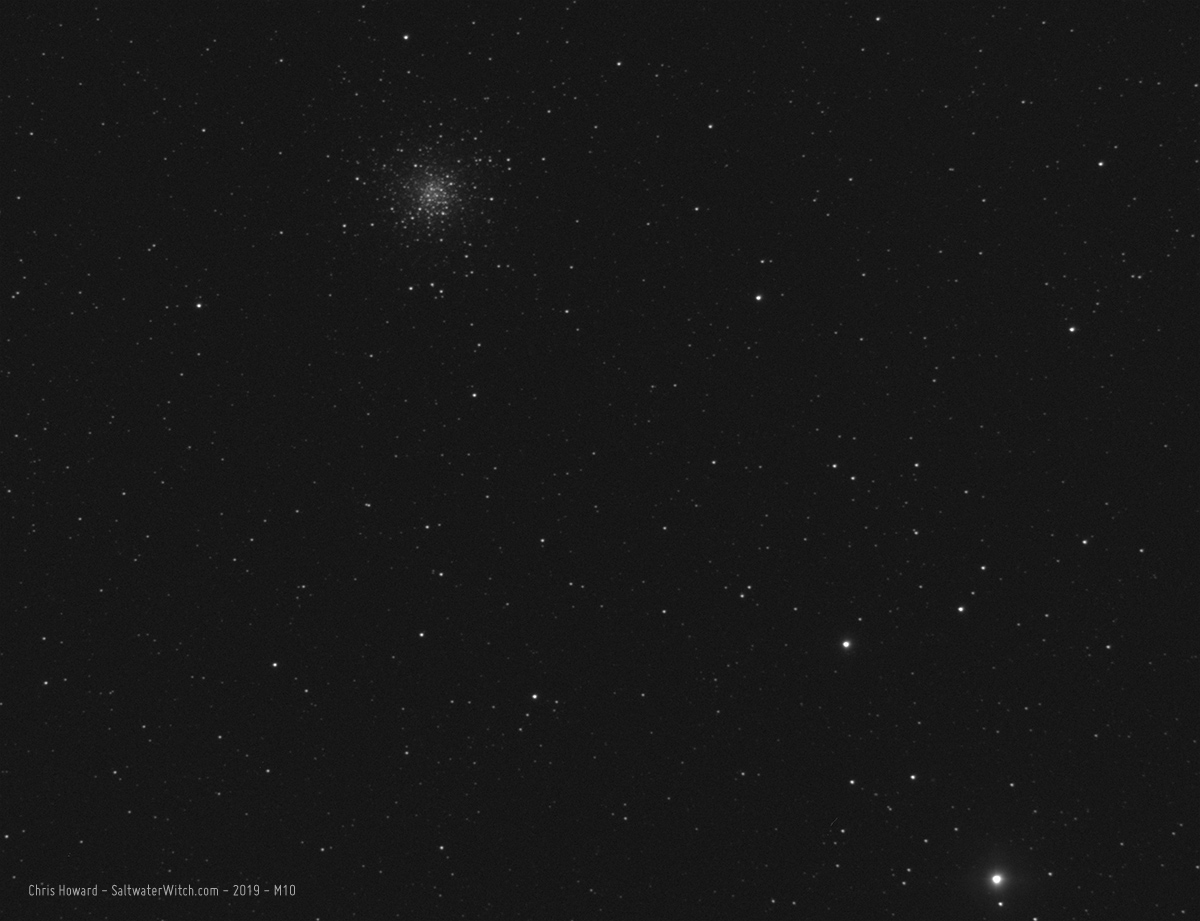
Messier 3 Cluster:
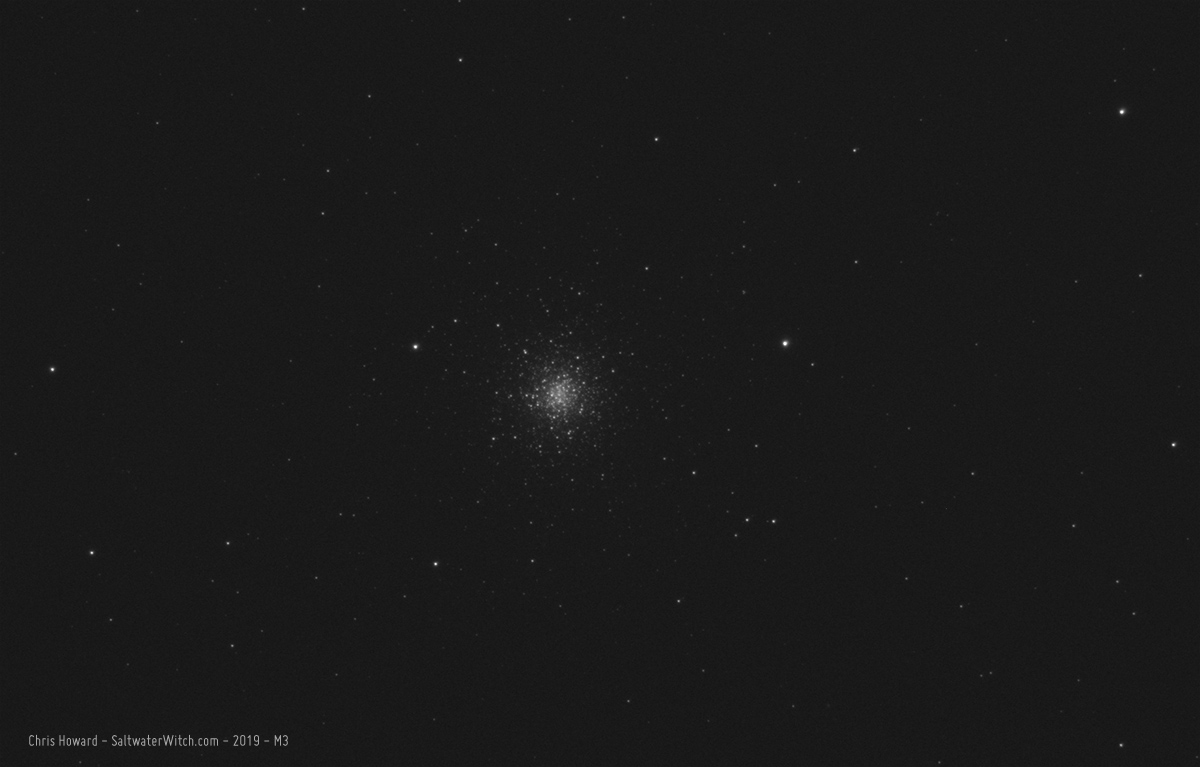
Messier 13 Cluster in Hercules:

Messier 13, Hercules Globular Cluster (also NGC 6205) - using the IR image as luminance with an old RGB version of M13:
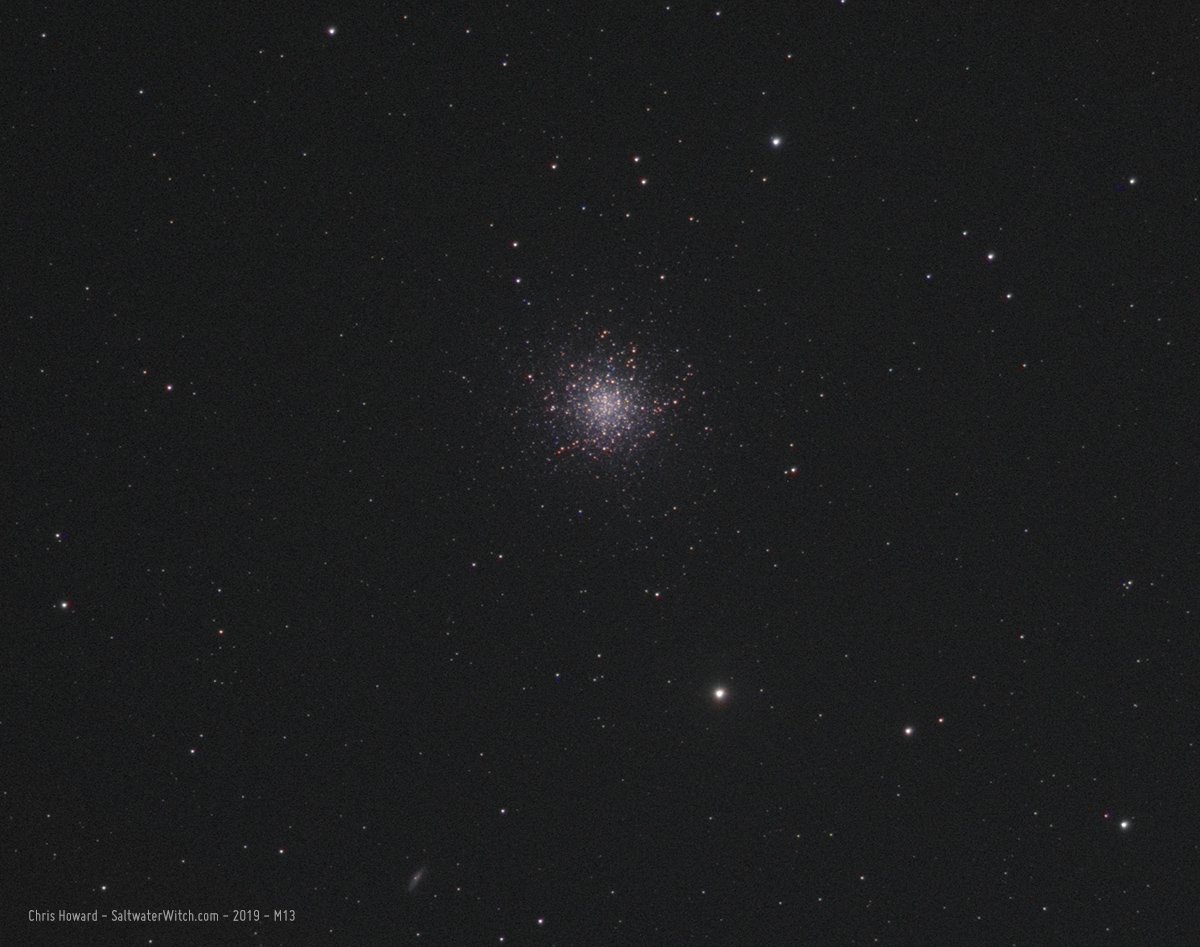
Messier 12 Cluster:
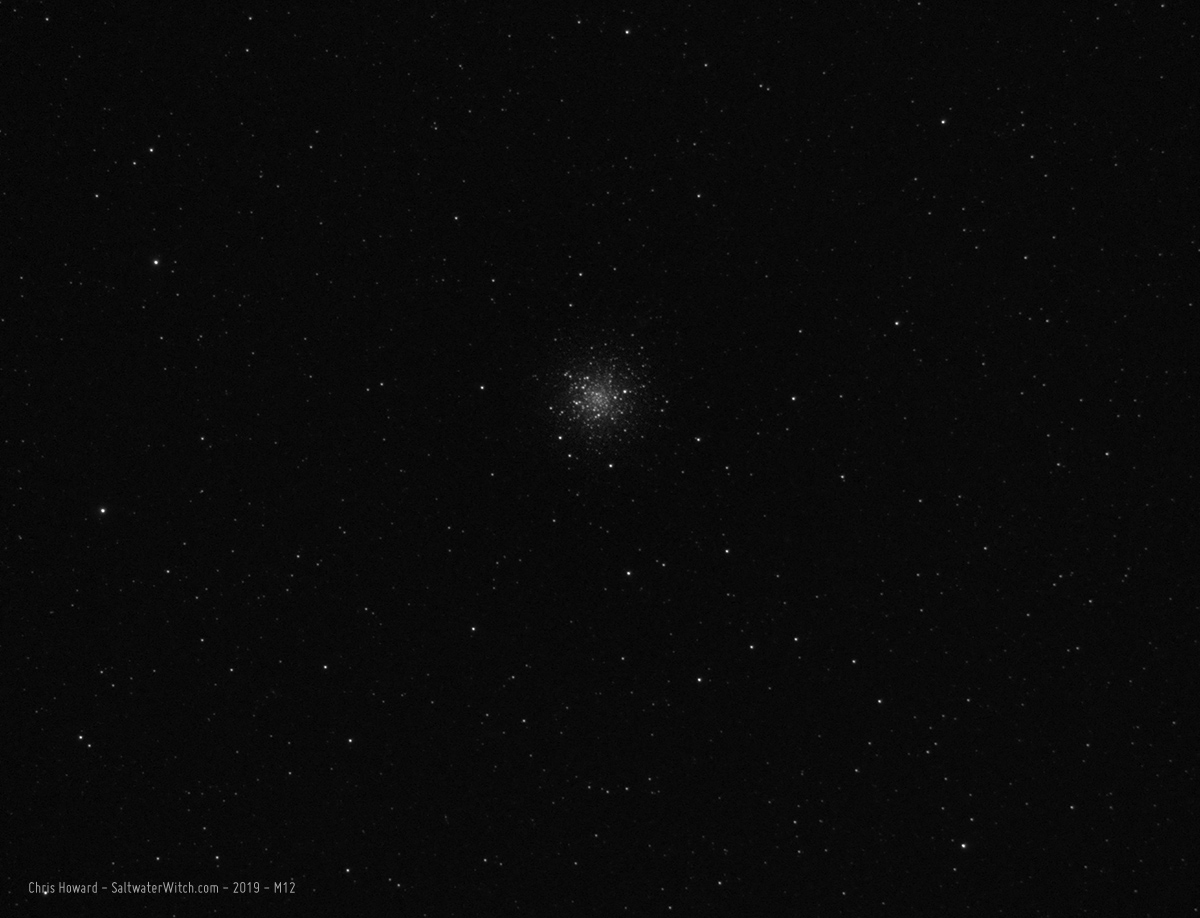
Posted May 23, 2019
NGC 2174 in the Hubble Palette and Bi-color HO
NGC 2174, the Monkey Head Nebula. I went with the Hubble Palette, SHO, on this one. Exposures: 24 x 120 seconds Ha, 26 x 120 seconds OIII, 24 x 120 seconds SII. Equipment: William Optics GT81 APO refractor, ZWO ASI1600MM-Pro monochrome 16MP camera (unity gain 139/21), Astronomik filters, iOptron CEM25P mount, INDI/Ekos/KStars control software. NGC 2174 is a faint emission nebula located in the constellation Orion, about 6400 light-years away. This was a test of my field setup that I'll taking on the road in a week. I'll have to come back to NGC 2174 with longer exposures--and more of them. And dark frames. I didn't shoot any calibration frames in this run.

Here's my processing of NGC 2174 in Hydrogen-alpha and Oxygen (without the Sulfur frames).

Posted February 22, 2019
NGC 2327 "Parrot Nebula" and IC 2177 "Seagull Nebula"
The dust and hydrogen gas of NGC 2327 "Parrot Nebula" and IC 2177 "Seagull Nebula" span 100 lightyears between the constellations Monoceros and Canis Majoris. This is another one from last night (New Years Day). After shooting the Flaming Star Nebula for several hours, I dropped down to IC 2177 for the remaining clear skies (up to around 1am). Neither of these targets are strong--or have anything showing up--in the oxygen bandpass. I ended up cutting the OIII frames and going with bi-color Ha and SII. Exposures: 28 x 300 seconds of Ha, 26 x 360 seconds of SII. Equipment: William Optics GT81 APO refractor, ZWO ASI1600MM-Pro monochrome 16MP camera (unity gain 139/21), Astronomik filters, iOptron CEM25P mount, INDI/Ekos/KStars running in Stellarmate/Raspberry Pi 3b+

Posted January 2, 2019
First astro session of the year!
The star at the core of this nebula is the "Flaming Star", AE Aurigae, in the constellation Auriga (The Charioteer), and all the surrounding dust and clouds of hydrogen is called the Flaming Star Nebula (IC 405). This emission nebula is around 1500 lightyears away and it's fairly large, about 5 lightyears across (roughly 47 trillion kilometers or 30 trillion miles across).
What's interesting is that even though AE Auriga is lighting up the nebula, it was not formed there, but rather is a "runaway star" that was probably ejected several million years ago from the star formation furnace in the core of the Orion Nebula. The star is moving quickly through the nebula, producing a violent bow shock with a wave of high energy electromagnetic radiation.
Frames: 23 x 300 seconds of Ha, 5 x 300 seconds of OIII (I was not picking up oxygen at all!), and 20 x 360 seconds of SII. Equipment: William Optics GT81 APO refractor, ZWO ASI1600MM-Pro monochrome camera (unity gain 139/21), Astronomik filters, iOptron CEM25P mount, INDI/Ekos/KStars running in Stellarmate/Raspberry Pi 3b+.
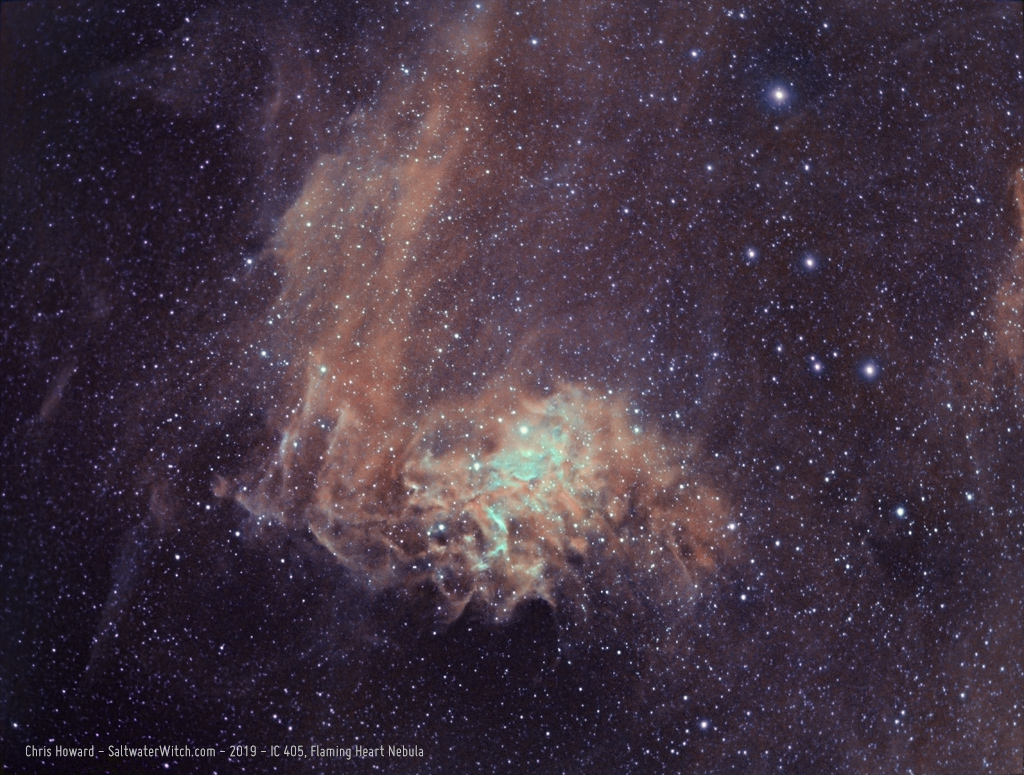
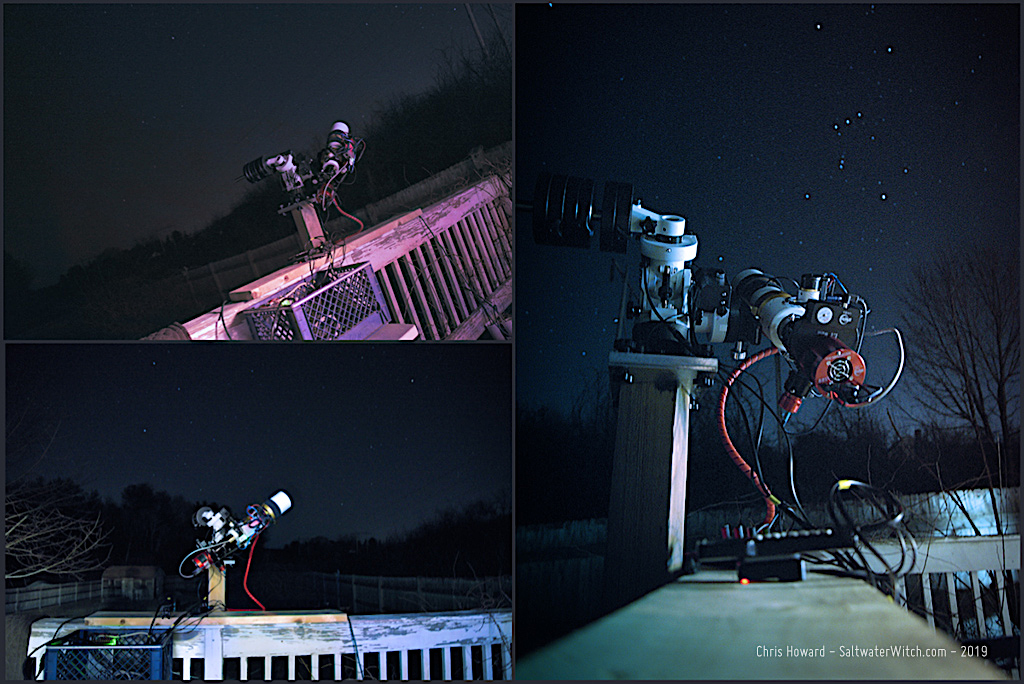
Posted January 2, 2019
Astro-imaging Highlights 2018
I put together a batch of images from my astrophotography sessions over the last year. This isn't in order, because a wanted a nice mix of color, narrowband, hydrogen-alpha only, wide-field, moon shots, along with some of my astro gear setups for some of these sessions.
Posted December 30, 2018
California Nebula - NGC 1499 Bi-color Ha + SII
NGC 1499, California Nebula in bi-color narrowband hydrogen-alpha and sulfur 2. I captured this data on the 25th, but didn't have time to capture oxygen 3 frames with high clouds moving in and the moon rising. Even so, I like the way this turned out with the two bandpasses, almost fluorescent. NGC 1499 is about 1000 lightyears away, and if you haven't guessed, it's called "California Nebula" because if you flip this image 90 degrees counterclockwise it looks like the state.

Posted December 28, 2018
Astro Session with the new ZWO ASI1600MM-Pro
Wide-field of M42, the Orion Nebula--and it's amazing how cloudy and dusty the whole area is. I spent half the night adjusting things--focus distance, off-axis guider spacing, but managed to capture M42 and the surrounding region (two sets of subs: 21 x 300 second, and 20 x 20 second for the bright Nebula core and Trapezium). Calibration frames: 20 Dark and 20 Bias, No flat frames. I shot these with the ZWO ASI1600MM-Pro monochrome camera, Astronomik 12nm Ha filter, William Optics ZS61 APO, iOptron CEM25P mount.
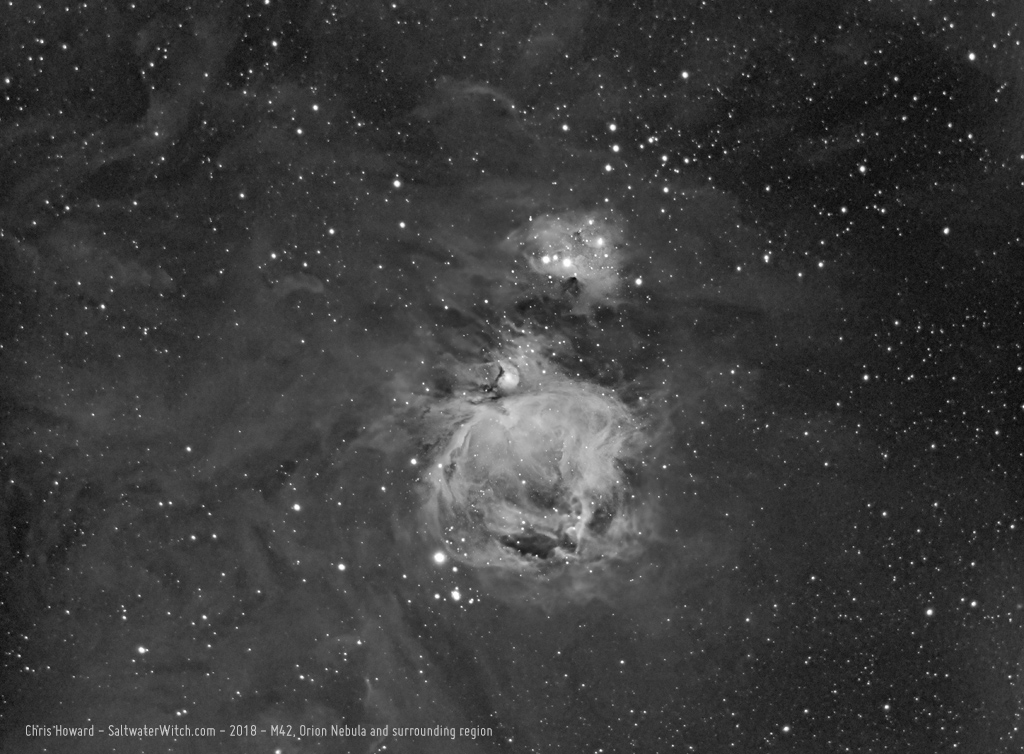
I also managed to capture a dozen frames of the California Nebula:

